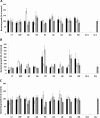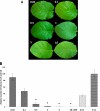Anti-phytopathogenic activities of macro-algae extracts
- PMID: 21673886
- PMCID: PMC3111179
- DOI: 10.3390/md9050739
Anti-phytopathogenic activities of macro-algae extracts
Abstract
Aqueous and ethanolic extracts obtained from nine Chilean marine macro-algae collected at different seasons were examined in vitro and in vivo for properties that reduce the growth of plant pathogens or decrease the injury severity of plant foliar tissues following pathogen infection. Particular crude aqueous or organic extracts showed effects on the growth of pathogenic bacteria whereas others displayed important effects against pathogenic fungi or viruses, either by inhibiting fungal mycelia growth or by reducing the disease symptoms in leaves caused by pathogen challenge. Organic extracts obtained from the brown-alga Lessonia trabeculata inhibited bacterial growth and reduced both the number and size of the necrotic lesion in tomato leaves following infection with Botrytis cinerea. Aqueous and ethanolic extracts from the red-alga Gracillaria chilensis prevent the growth of Phytophthora cinnamomi, showing a response which depends on doses and collecting-time. Similarly, aqueous and ethanolic extracts from the brown-alga Durvillaea antarctica were able to diminish the damage caused by tobacco mosaic virus (TMV) in tobacco leaves, and the aqueous procedure is, in addition, more effective and seasonally independent. These results suggest that macro-algae contain compounds with different chemical properties which could be considered for controlling specific plant pathogens.
Keywords: Botrytis cinerea; Phytophthora cinnamomi; macro-algae; plant pathogen; tobacco mosaic virus (TMV).
Figures








Similar articles
-
Different Antifungal Activity of Anabaena sp., Ecklonia sp., and Jania sp. against Botrytis cinerea.Mar Drugs. 2019 May 20;17(5):299. doi: 10.3390/md17050299. Mar Drugs. 2019. PMID: 31137530 Free PMC article.
-
Anticancer and antimicrobial activity of biosynthesized Red Sea marine algal silver nanoparticles.Sci Rep. 2022 Feb 14;12(1):2421. doi: 10.1038/s41598-022-06412-3. Sci Rep. 2022. PMID: 35165346 Free PMC article.
-
Evaluation of in vitro anti-Leishmanial activity of some brown, green and red algae from the Persian Gulf.Eur Rev Med Pharmacol Sci. 2011 Jun;15(6):597-600. Eur Rev Med Pharmacol Sci. 2011. PMID: 21796865
-
[Brown Seaweeds as a Source of New Pharmaceutical Substances with Antibacterial Action].Antibiot Khimioter. 2015;60(3-4):31-41. Antibiot Khimioter. 2015. PMID: 26415381 Review. Russian.
-
In vitro antioxidant properties of crude extracts and compounds from brown algae.Food Chem. 2013 Jun 1;138(2-3):1764-85. doi: 10.1016/j.foodchem.2012.11.026. Epub 2012 Nov 16. Food Chem. 2013. PMID: 23411309 Review.
Cited by
-
Seaweed-Based Products and Mushroom β-Glucan as Tomato Plant Immunological Inducers.Vaccines (Basel). 2020 Sep 13;8(3):524. doi: 10.3390/vaccines8030524. Vaccines (Basel). 2020. PMID: 32933148 Free PMC article.
-
Extracellular Metabolites of Heterotrophic Auxenochlorella protothecoides: A New Source of Bio-Stimulants for Higher Plants.Mar Drugs. 2022 Sep 7;20(9):569. doi: 10.3390/md20090569. Mar Drugs. 2022. PMID: 36135758 Free PMC article.
-
Antimicrobial Action of Compounds from Marine Seaweed.Mar Drugs. 2016 Mar 9;14(3):52. doi: 10.3390/md14030052. Mar Drugs. 2016. PMID: 27005637 Free PMC article. Review.
-
Different Antifungal Activity of Anabaena sp., Ecklonia sp., and Jania sp. against Botrytis cinerea.Mar Drugs. 2019 May 20;17(5):299. doi: 10.3390/md17050299. Mar Drugs. 2019. PMID: 31137530 Free PMC article.
-
Investigation of Marine-Derived Fungal Diversity and Their Exploitable Biological Activities.Mar Drugs. 2015 Jun 30;13(7):4137-55. doi: 10.3390/md13074137. Mar Drugs. 2015. PMID: 26133554 Free PMC article.
References
-
- Spoel S, Dong X. Making sense of hormone crosstalk during plant immune responses. Cell Host Microbe. 2008;3:348–351. - PubMed
-
- Dodds PN, Rathjen JP. Plant immunity: Towards an integrated view of plant-pathogen interactions. Nature. 2010;11:539–548. - PubMed
-
- Delattre C, Michaud B, Courtois B, Courtois J. Oligosaccharides engineering from plants and algae applications in biotechnology and therapeutics. Minerva Biotechnol. 2005;17:107–117.
-
- Chandía NP, Matsuhiro B. Characterization of a fucoidan from Lessonia vadosa (Phaeophyta) and its anticoagulant and elicitor properties. Int J Biol Macromol. 2008;42:235–240. - PubMed
-
- Gonzalez del Val A, Platas G, Basilio A, Cabello A, Garrochategui J, Suay I, Vicente F, Portillo E, Jimenez del Rio M, Reina G, Pelaez F. Screening of antimicrobial activities in red, green and brown macroalgae from Gran Canaria (Canary Islands, Spain) Int Microbiol. 2001;4:35–40. - PubMed
Publication types
MeSH terms
Substances
LinkOut - more resources
Full Text Sources
Other Literature Sources
Molecular Biology Databases

